1
William Carleton
1794-1869 | Writer and Poet
Brief History:
A literary figure of the mid-Victorian period who dealt with a traditional native Irish theme.
Began his literary career as a poor Catholic scholar who later on converted to Protestantism
Wrote the Traits and Stories of the Irish Peasantry, The Lough Derg Pilgrim and the poems The Midnight Hour and The Priest’s Funeral.
Description of Monument:
A 2 metre high limestone memorial spire with a bust of William Carleton, resting on a limestone plinth.
Direction to Grave:
The grave is located just off the right hand side of the Main Avenue, behind the vaults on the road edge, 60 metres from the Victorian Chapel doors.
Grave No: C 130 – 3754
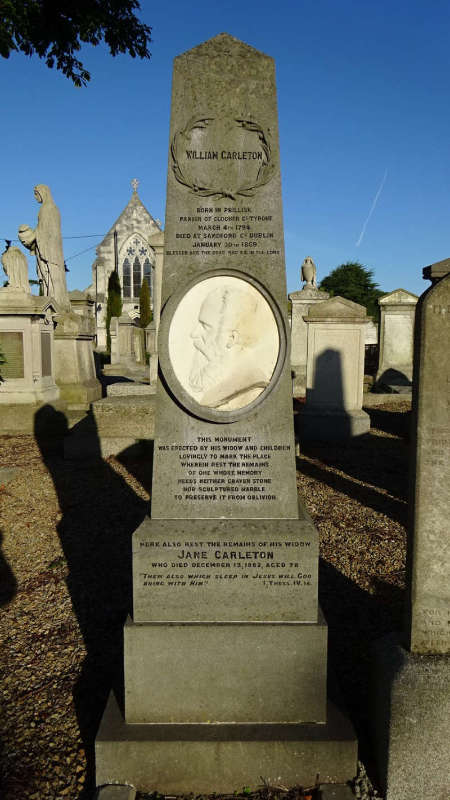
2
Thomas Kirk
1781-1845 | Sculptor
Brief History:
Sculptured statue of Horatio Nelson that stood on top of a memorial column in O’Connell Street
Foundation member of Royal Hibernian Academy in 1822.
Many of his statues can be seen at the Royal College of Surgeons, the Royal Dublin Society (RDS) and the Library of Trinity College.
Description of Monument:
A large statue of a woman positioned on a Portland pedestal on top of a granite vault on edge of cemetery main avenue.
Directions to Vault:
Vault is located 50 metres from the doors of the Victorian Chapel on the right hand side of the edge of the Main Avenue.
Vault No: C 130 – 843

3
William Wilde
1815-1876 | Doctor and Father of Oscar Wilde
Brief History:
Established first eye and ear teaching hospital in Ireland and England, St. Marks on Westland Row.
Surgeon Oculist to Queen Victoria.
Author of many works on the history and antiquities of Ireland
Father to Oscar Wilde.
Description of Monument:
Granite monument with white marble tablet inset on top of a granite vault
Directions to Vault:
This vault is located opposite the coffee shop and office buildings, on the edge of the road way. It is the 3rd vault from the Main Avenue.
Vault No: C 108 – 678
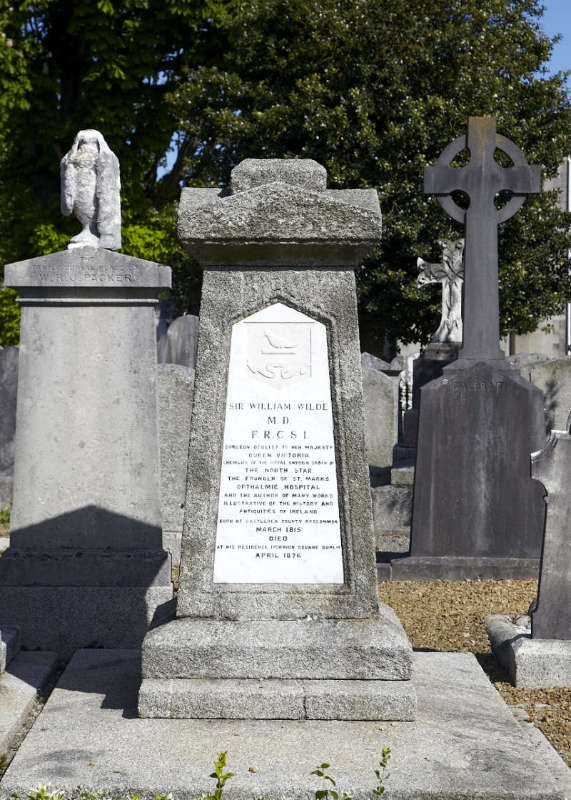
4
Alexander Findlater
1797-1873 | Food and Drink Merchant
Brief History:
Alexander Findlater established his company in 1823 and became one of the largest distributors of food and drink in Ireland in the 19th century.
Eventually grew into 23 shops across (mainly) Dublin and Ireland.
In partnership with Independent Newspapers, established the Dublin Electricity Light Company.
Findlater’s Mountjoy Brewery was second to Guinness in the production and export of porter stout and ale.
Company exists today as a distributor of fine wines and spirits.
Description of Vault:
A large granite tomb on top of a granite vault.
Directions to Vault:
Walk 35 metres along the Guinness Walk from the grey power pole that lies across the coffee shop and office buildings. On the left hand side edge of the Walk, you will see the prominent Findlater Vault, opposite the Garden Chapel.
Vault No: C 81 – 392

5
Arthur Guinness the Second
1768-1855 | Guinness Brewery
Brief Historical:
Arthur Guinness first established the Guinness brewery in 1759. He died in 1803 and is buried in Oughterard graveyard in Co. Kildare.
However his sons are credited with growing the company to become the largest brewery in Ireland by 1840. From this initial expansion, Guinness has grown into the huge company it is today.
There are 14 members of the Guinness family interred in this vault. The most prominent individual being Arthur Guinness the Second.
Description of Monument:
A large granite tomb on top of a granite vault.
Directions to Vault:
Walk along the Guinness walk to where it intersects with the South Walk.
Just behind the yew hedging, 8 metres set back from this intersection, on your right hand side you will see the Guinness vault.
Vault No: C 5 – 558

6
Jacob Owen
1778-1870 | Architect and Engineer
Brief History:
Appointed Architect and Engineer to Board of Works 1832.
Involved with the reconstruction programme of Dublin Castle and the Four Courts.
Founder of the Civil Engineers Society of Ireland in 1835.
Construction of the Church of Ireland in Dalkey.
Involved in the design of Dundrum Mental Asylum.
Supervised the construction of Mountjoy Jail.
Description of Monument:
Granite vault on edge of South Walk.
Directions to Vault:
Walk along the full length of the Guinness Walk from the Main Avenue. Turn left at the T junction for the South Walk.
Walk for 25 metres along the South Walk (heading for the cemetery wall). On your left you will see a Charles Tuthill and Ferguson Hendley Vault on the road edge.
Directly opposite this vault is the vault of Jacob Owen which is to the right of and alongside the vault of Alexander Reid.
Vault No: B 210 – 2309

7
Sir Richard Griffith
1784-1878 | Geologist
Brief Historical:
Appointed Chief Commissioner of Valuation of Lands in Ireland in 1827.
Published Geological map of Ireland in 1839.
Chairman of Board of Works in 1850.
Conducted a valuation of Irish property in every townland and parish in 1854.
Vast wealth of information from this valuation was used for Government taxation, determine election franchises and to regulate spirit licences.
He was knighted for this huge undertaking in 1858.
The information provided by this survey is still used today by genealogists.
Description of Monument:
Granite monument and marble book on top of a granite vault on edge of East Walk.
Directions to Vault:
Vault is the 8th vault along the edge of the East Walk, as you walk from the Main Avenue. It is opposite a Whiteside vault which is located along the side of the Victorian Chapel.
Vault No: C 87 – 2276

8
Sir Richard Morrison
1767-1849 | Architect
Brief History:
Designed Clonmel Courthouse.
Designed Clonmel Cathedral and Spire.
Supervising Architect to the Dublin Pro-Cathedral.
Architect to Trinity College.
Designed Sir Patrick Dunn’s Hospital Dublin.
Designed numerous courthouses; Cork, Galway, Naas, Portlaoise, Trim and Wexford.
Designed Ballyheigue Castle, Castle Howard and Castle Freke.
Description of Monument:
This is a vault with iron railings around it.
Directions to Vault:
Turn right onto Hawthorn Walk from the Main Avenue. At the Long Walk intersection, turn left onto clay roadway (Broughton Vault is on your left hand side at this intersection).
Walk 15 metres along this clay roadway and turn left onto a 2 metre wide clay pathway.
Walk a further 6 metres and turn sharp right. The Morrison vault is in front of you.
Vault No: C 63 – 199

9
William C. Plunket
1828-1897 | Fourth Lord Plunket and Archbishop of Dublin
Brief History:
Appointed Archbishop to Dublin in 1884.
Elected Archbishop of the united diocese of Dublin, Glendalough and Kildare.
Instrumental in reviving the Kildare Place Schools, the Church of Ireland teacher training college.
Actively opposed the Church Act of 1869 to disestablish and disendow the Anglican Church of Ireland.
Heavily involved in the Protestant reform movement in Spain, Portugal and Italy.
There is a statue erected to him beside the Irish Natural museum on Kildare Street, Dublin 2.
Description of Monument:
Large 5 metre wide granite (unnamed) vault, which is on the edge of the Hawthorn Walk.
Directions to the Vault:
Walk 70 metres along the Hawthorn Walk via the Main Avenue. The Plunkett vault is on your right hand side, directly opposite the Greene vault which has a green steel door.
It is the second vault from the TM Gresham vault, located at the junction of the Long Walk.
Vault No: C 91- 145

10
John Millington Synge
1871-1909 | Writer
Brief History:
Was friendly with both William Butler and Jack B. Yeats and worked with them both on various collaborations.
Wrote such plays as The Shadow of the Glen, Riders to the Sea, The Well of the Saints and The Tinkers Wedding.
Synge is most remembered for his famous play, The Playboy of the Western World, staged by the Abbey Theatre in 1907.
This play provoked a great deal of conflict caused by the apparent slur on Irish womanhood. There were riotous demonstrations and the police were called.
Description of Grave:
Marble headstone on granite base.
Directions to Grave:
Proceed along the Hawthorn Walk via the Main Avenue. 12 metres past the intersection for the Long Walk, you will see on your left hand side a double headstone called Hudson, on the edge of the Walk.
(At this stage take note of an angel statue, 30 metres or so behind the Hudson grave, in the direction of the building in the background).
Walk along the small shale walkway left of Hudson grave for 7 metres and turn right onto a similar shale pathway. Proceed for 28 metres and turn left onto another small pathway. Synge’s grave is the 2nd grave on your right.
The angel statue noted above is 7 metres away and is called Jones.
Grave No: C 38 – 9468

11
Jack Butler Yeats
1871-1957 | Artist
Brief History:
Brother of William Butler Yeats, Jack B. Yeats became an internationally renowned artist in his own right.
First Irish artist to hold exhibitions at the Tate and National Galleries in London.
Some of his most celebrated paintings reflected the turbulent times of early 20th century Ireland, such as The Liffey Swim, Bachelor’s Walk and Grief.
He also wrote a number of short poems, prose works and plays during his life such as, Sligo, Sailing Swiftly, The Charmed Life, Apparitions, La La Noo and in Sand.
In 1945, he received his first formal tribute when 180 of his paintings appeared at the National Loan Exhibition.
His final paintings included Entrance of a Lady with Attendants, Out of the Mountainside and Sleep Sound.
Description of Monument:
Limestone headstone, base and cover slab.
Directions to Grave:
Walk 14 metres along Neville’s Walk via the Hawthorn Walk. Turn left at a Hunt grave on the road edge on you left hand side. Walk 17 metres along the small pathway and the Yeats grave is on your right beside a Healy white marble headstone.
Grave No: C 41 – 27646

12
George Fitzmaurice
1877-1963 | Playwright
Brief History:
Wrote many plays primarily for the Abbey Theatre Dublin that were also shown in England and America
These plays included The Country Dressmaker, The Pie-dish, The Moonlighter, The Magic Glasses, The Cobble and The Dandy Dolls.
Description of Monument:
White marble headstone on limestone base with a carving of George Fitzmaurice on it.
Directions to Grave:
Walk 25 metres along Neville’s Walk via the Hawthorn Walk and turn left onto a small pathway. The distinctive headstone is the 3rd grave on your left.
Grave No: C 19 – 29414
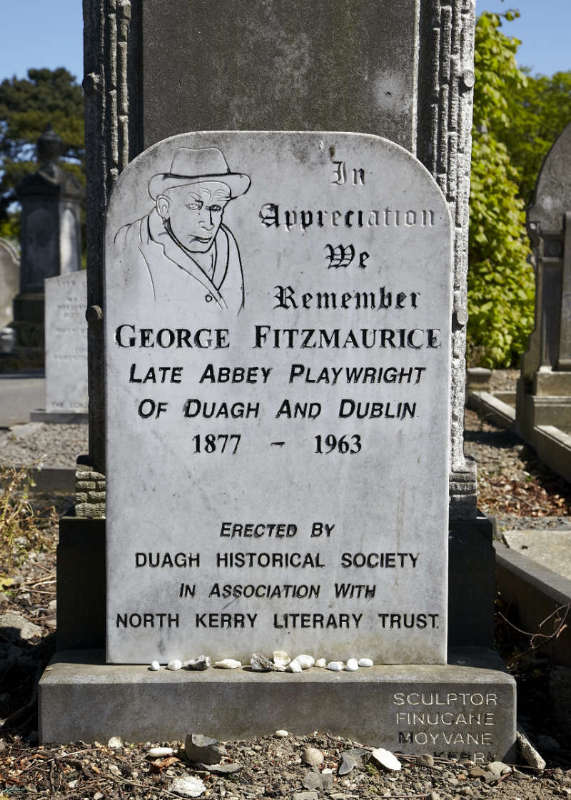
13
Robert Graves
1796-1853 | Physician
Brief History:
Physician to the Meath Hospital where he developed bedside teaching, which was adopted throughout Europe and America.
Promoted the importance of feeding fever patients to alleviate systems.
President of the Royal college of Physicians in 1843.
Fellow of the Royal Society in 1849.
Associated with a study of the thyroid gland, now known as the “Graves disease”.
Description of Monument:
Portland monument on top of a granite vault.
Directions to vault:
Walk 24 metres along Neville’s Walk via the Hawthorn Walk. The vault is located at the edge of the Walk, on your right hand side. The vault is to the left and alongside a Matthew Shanley double plot, which has a single portland headstone and iron railings around it.
Vault No: C 19 – 1698

14
Joseph Sheridan Le Fanu
1814-1873 | Writer
Brief History:
Was a famous Gothic author who wrote about the supernatural.
Wrote Uncle Silas, The Cock and the Anchor, House by the Churchyard, Wylder’s Hand, All in the Dark and Haunted Lives.
Owned several Dublin newspapers and magazines.
Description of Monument:
Limestone slab on a granite vault, which is on the edge of the Nuns’s Walk.
Directions to Vault:
Walk 75 metres along Nun’s Walk via the Low Walk. On your left hand side you will see three Purser graves side by side. The Le Fanu vault is opposite these graves and to the left and alongside a Keane marble headstone on the road edge.
Vault No: C122 – 399
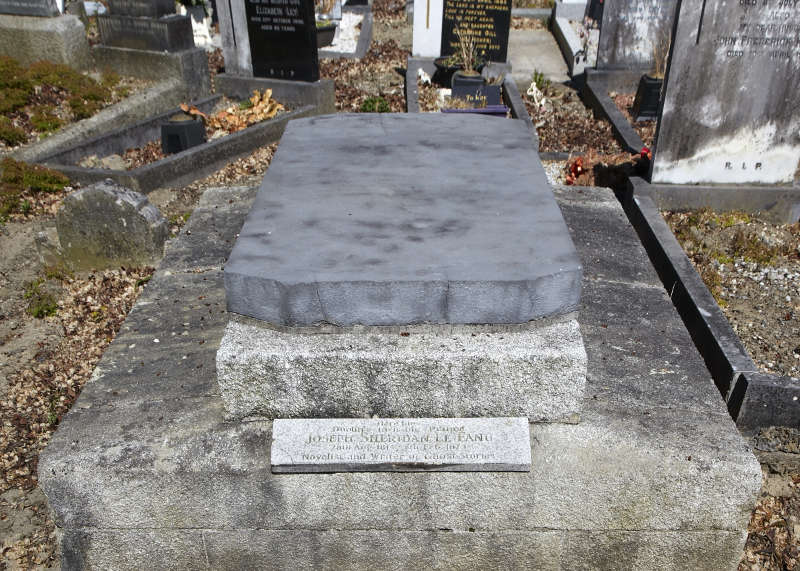
15
AE Russell
1867-1935 | Writer and Artist
Brief History:
One of the prominent members of the Irish Literary Revival that emphasised Irish nationalism and separatism form Britain.
Active member of the co-operative movement set up by Sir Horace Plunkett
Prolific painter of many scenes from children playing to mystic themes
Member of the group that founded the Abbey Theatre in 1904
Close friend and neighbour of William Butler Yeats
Collection of poems and prose include Homeward Songs by the Way, the Earth Breath and other Poems, the Divine Vision, Collected Poems, Enchantment and the House of Titans and other poems
His novels include the Interpreters and the Avatars.
Description of Monument:
Limestone headstone, base and kerbing. On the headstone is engraved;
“I moved among men and places
and in living I learned the
truth at last. I know I
am a spirit and that I went
forth in old time from the
self-ancestral to labours yet
unaccomplished”
Direction to Grave:
Turn right onto Consecration Walk from Archbishop’s Walk. Approximately count 27 graves along the edge of the Walk. You will come to a Kathleen Thompson headstone beside that of a Jack O’Rourke.
AE Russell’s grave is the 5th grave directly behind Kathleen Thompson. Follow the small shale pathway close to Jack O’Rourke’s grave into this section for access.
Grave No: A76 – 401 – 11217
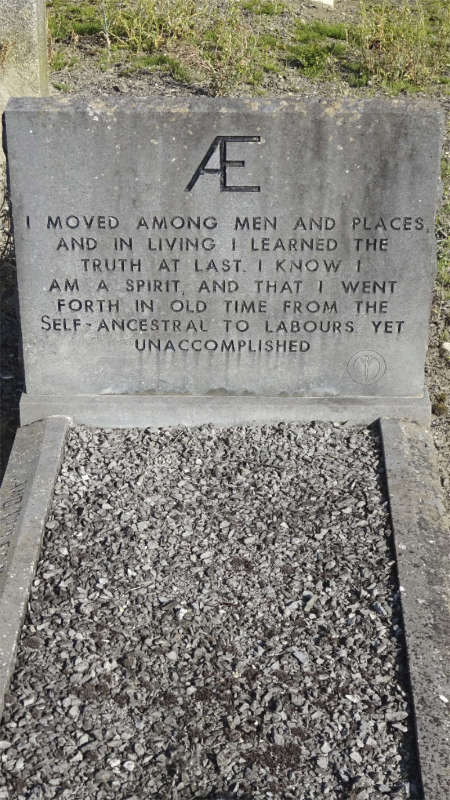
16
Dublin Metropolitan Police
1884-1911
Brief History:
The police force for the Dublin City which was established in 1786. This was a separate force, run independently from the Royal Irish Constabulary (RIC).
Description of Monument:
Large 11 x 8 foot grave with a limestone monument. An iron railing encloses the grave.
Directions to Grave:
Walk 90 metres along the Laburnam Walk via the Main Avenue. You will see the vault of the Honer family on your right, on the edge of the walk. Just opposite this vault, on your left hand side is the Dublin Metropolitan plot.
Grave No: C 135 / 136 – 5621

17
Sir William Rowan Hamilton
1805-1865 | Mathematician and Astronomer
Brief History:
A brilliant mathematician and astronomer who was knighted for his works in these fields of science in 1835.
Appointed Andrews Professor of Astronomy in 1827 whilst still an undergraduate.
Appointed Superintendent of the Observatory and Astronomer Royal for Ireland at Dunsink Observatory until his death in 1865.
In 1827 wrote Theory of Systems of Rays which contained the phenomenon as conical refraction.
In 1837 appointed President of the Royal Irish Academy.
In 1834 published General Methods of Dynamics that later influenced Erwin Schodinger in his work on quantum mechanics.
In 1835 he was one of the first scientists to believe that a separate science of time was required. This was fully realised in1905 by Albert Einstein.
In 1843 published his most famous discovery was The Theory of Quaternions which paved the way for quantum mechanics and nuclear physics.
In 1846 Hamilton introduced a new method of describing planetary orbit called Hodography.
Close association with Trinity College, with the new Science Building named in his honour.
His statue stands at the entrance to the Government Buildings in Merrion Street.
Description of Monument:
Portland headstone on a granite base.
Directions to Grave:
Turn right onto the Long Walk via the Hawthorn Walk. Proceed for 65 metres and turn right at a Beasley vault into a metre wide pathway. The Hamilton grave is further along 8 metres on your right hand side on the edge of this pathway.
Grave No: C 116 – 3489

18
Thomas Davis
1814-1845 | Writer and Irish Patriot
Brief History:
One of the most noted Irish Patriots of the 19th century.
He epitomised this era by his idealism and freedom from bigotry.
Was a member of the Repeal Association in 1840 under the leadership of Daniel O’Connell.
A co-founder of the Young Ireland Movement.
A co-founder of the hugely successful Nation newspaper in 1842 which promoted Irish nationality by inspiring a love for the Irish history, culture and language.
Wrote many stirring poems an ballads such as A Nation Once Again, The West Awake, Clare’s Dragoons, My Grave and Sack of Baltimore.
Description of Monument:
Limestone celtic cross and pedestal on top of a granite vault.
Directions to Vault:
Turn right onto the Long Walk via the Hawthorn Walk. Proceed 65 metres until you come to a metre wide pathway on your right. Walk 25 metres along this pathway and turn right onto a narrow pathway. The Davis vault is the first vault on your left.
Vault No: C 115 – 5474

19
Thomas Drummond
1797-1840 | Under Secretary of Ireland 1835-1840
Brief History:
Captain in the Royal Engineers.
Head of the Boundary Commission 1832.
Private Secretary to the Chancellor of the Exchequer.
Under Secretary of Ireland from 1835 until his death 1840.
It was during his tenure as Under Secretary of Ireland that Thomas Drummond is best remembered for. It became known as the Drummond Era. His was the first administration to show that Ireland could be governed impartially and not for the benefit of vested interests.
He tackled the injustices of the legal system, the growing orange order movement and established a centralised and well run Police force. However his untimely death meant that he could not follow through on his many initiatives.
The Drummond era was a brief glimpse of what might have been, had as effort been made over an extended period to enforce the law impartially but effectively.
Description of Monument:
It is a large sarcophagus with laurel leaf mouldings supported by a massive Portland stone pedestal on top of a granite vault. It is the tallest monument in the cemetery.
On it is engraved;
I wish to be buried in Ireland, the country of
my adoption – a country which I have loved,
which I have faithfully served and for which
I believe I have sacrificed my life
Directions to Vault:
This is the tallest monument in the cemetery and is not hard to find. Walk 60 metres along the Hawthorn Walk via the Main Avenue until you see the impressive Cusack vault (with 10 Tuscan pillars) on your left hand side.
Just opposite the Cusack vault 20 metres on the far side of the road is the Thomas Drummond vault. Access is by a narrow pathway behind the McCay vault.
Vault No: C 90 – 323

20
Royal Irish Constabulary
1884-1960
Brief History:
The Irish Constabulary was renamed the Royal Irish Constabulary (RIC) in 1867. The RIC was the provincial police force for Ireland up until it was disbanded in 1922, following the establishment of the Irish Free State.
Even though in 1913 86% of the force was catholic, sectarianism was rife within the force, especially when it came to promotion. As a result the RIC was not a well trusted police force.
There are 40 members of the RIC interred in this large plot. The first burial took place in 1884 and the last in 1960.
Description of Monument:
Large 25 x 21 foot grave, enclosed with granite kerbing with a distinctive 4 metre tall red granite obelisk.
Directions to Grave:
Turn right onto the Long Walk via the Hawthorn Walk. Walk 40 metres and turn left onto a narrow pathway. You will see the distinctive 4 metre high red granite obelisk marking the plot.
Grave No: Ac 93 /94 – 6196

21
The Huguenots
1713-1830
Brief History:
This large communal plot is the result of the exhumation of Huguenot graveyard at Bishop Street in 1966. The Huguenots were originally French Protestants who fled religious persecution from the French Monarchy in the mid 16th century.
Description of Monument:
A very long grey limestone headstone, 9 metres in length by 2 metres in height. The names of all the approximately 300 remains re-interred in Mount Jerome are inscribed on the headstone.
Directions to Grave:
Turn right onto the Hawthorn Walk via the Main Avenue. Proceed for 110 metres and turn right at a crossroads onto the Long (shaled surfaced) Walk. Proceed for 17 metres and turn left onto a small path, located along the left hand side of a Charles Whitton vault.
The Huguenot plot is 25 metres in front of you, directly behind other large communal plots of St. Thomas and St. Bride’s Graveyards. You will have to follow the small path around to the left side of these other two large communal plots to arrive at the Huguenot communal plot.
Grave No: Ac 67 / 94 – 39057
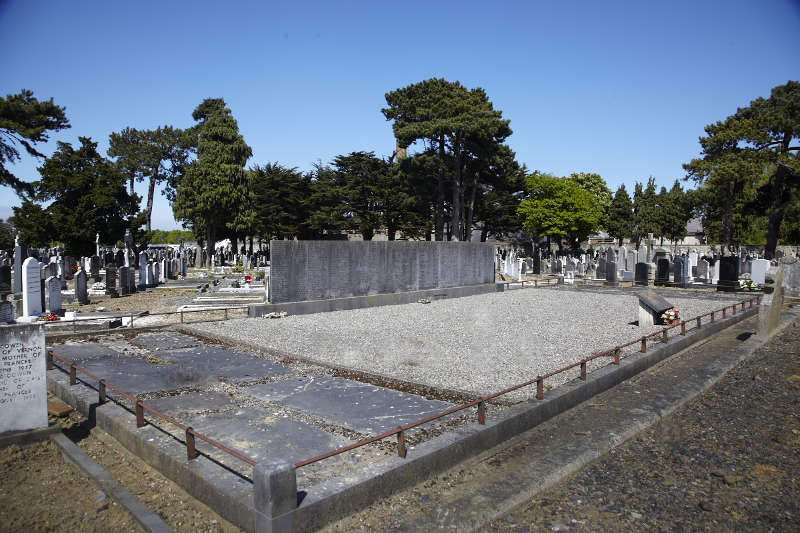
22
Bindon Blood Stoney
1828-1909 | Engineer
Brief History:
A groundbreaking Irish engineer who became Chief Engineer at Dublin Port in 1867. During his tenure, he was responsible for designing the modern quay walls of the River Liffey using a revolutionary notion of pre-cast concrete blocks and an underwater diving bell (which he invented himself). He also designed the O’Connell Bridge, Grattan Bridge and Butt Bridge.
Description of Monument:
A 2 metre high limestone Celtic Cross with double limestone kerbing
Direction to Grave:
Walk 80 metres along the Laurel Walk until you see on your right a Hetherington headstone, alongside a shale pathway. Turn right onto this pathway and walk 20 metres until it turns to the left. Proceed a further 10 metres and then turn sharp right where you will see the monument 3 metres in front of you.
Grave No: C 106 – 13102

23
Abraham Colles
1773-1843 | Surgeon
Brief History:
Appointed President of the Royal College of Surgeons at age 29.
Appointed to the chair of surgery at age 31 and held this position for 32 more years.
His description of the effects of syphilis on children became known as Colles Law.
Regarded as one of the most prominent surgeons of the 19th century.
First surgeon in Europe to tie the innominate artery.
Description of Monument:
Large limestone headstone on top of a granite vault.
Directions to Vault:
Turn right onto the Long Walk via the Hawthorn Walk. Walk 13 metres. The Colles vault in on your right hand side, on the edge of the Long Walk.
Vault No: C 92 – 744

- 1William Carleton
- 2Thomas Kirk
- 3William Wilde
- 4Alexander Findlater
- 5Arthur Guinness the Second
- 6Jacob Owen
- 7Sir Richard Griffith
- 8Sir Richard Morrison
- 9William C. Plunket
- 10John Millington Synge
- 11Jack Butler Yeats
- 12George Fitzmaurice
- 13Robert Graves
- 14Joseph Sheridan Le Fanu
- 15AE Russell
- 16Dublin Metropolitan Police
- 17Sir William Rowan Hamilton
- 18Thomas Davis
- 19Thomas Drummond
- 20Royal Irish Constabulary
- 21The Huguenots
- 22Bindon Blood Stoney
- 23Abraham Colles


